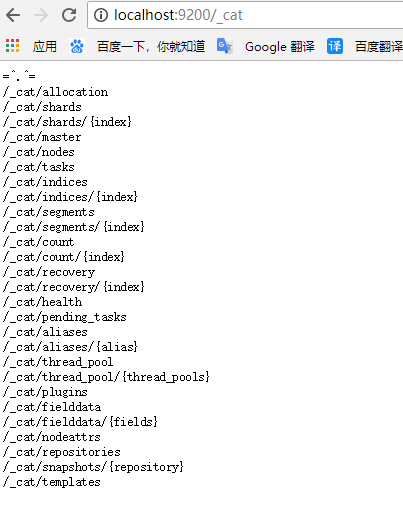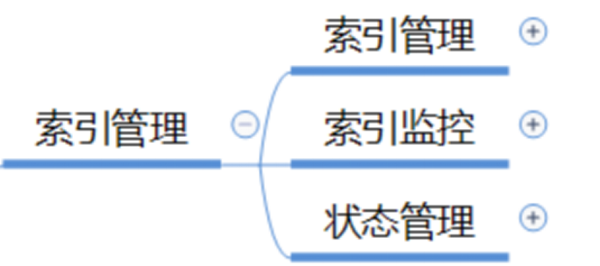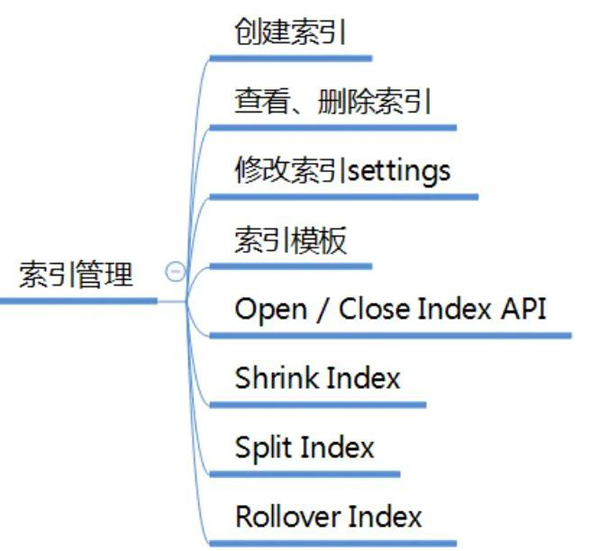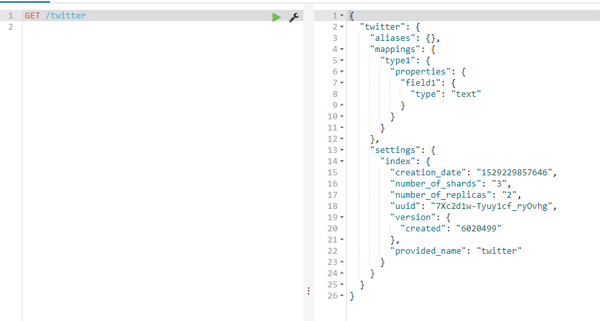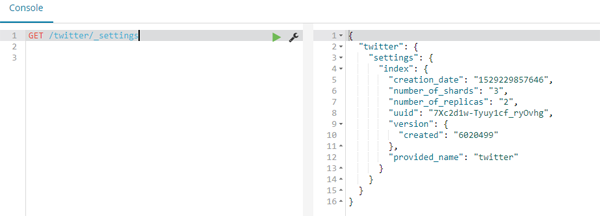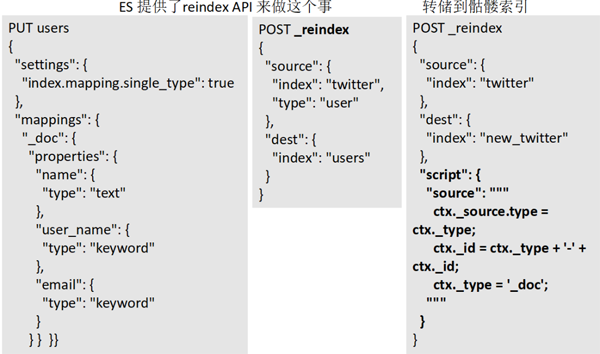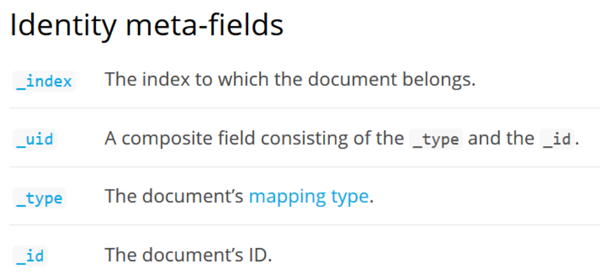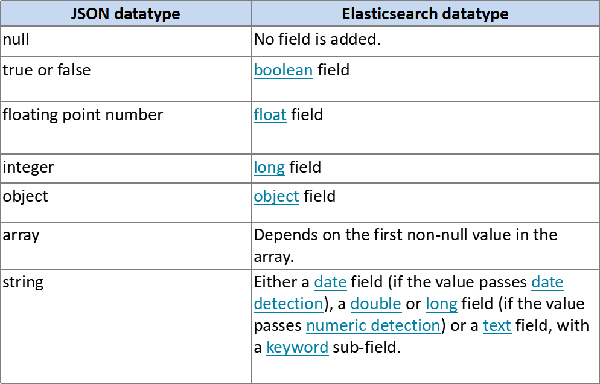ElasticSearch最全詳細使用教程
本文介紹了ElasticSearch的必備知識:從入門、索引管理到映射詳解。
一、快速入門
1. 查看集群的健康狀況
http://localhost:9200/_cat/health?v
說明:v是用來要求在結果中返回表頭
狀態值說明
Green - everything is good (cluster is fully functional),即最佳狀態
Yellow - all data is available but some replicas are not yet allocated (cluster is fully functional),即數據和集群可用,但是集群的備份有的是壞的
Red - some data is not available for whatever reason (cluster is partially functional),即數據和集群都不可用
查看集群的節點
2. 查看所有索引
http://localhost:9200/_cat/indices?v
3. 創建一個索引
創建一個名為 customer 的索引。pretty要求返回一個漂亮的json 結果
PUT /customer?pretty
再查看一下所有索引
http://localhost:9200/_cat/indices?v
GET /_cat/indices?v
4. 索引一個文檔到customer索引中
- curl -X PUT "localhost:9200/customer/_doc/1?pretty" -H 'Content-Type: application/json' -d'
- {
- "name": "John Doe"
- }
- '
5. 從customer索引中獲取指定id的文檔
- curl -X GET "localhost:9200/customer/_doc/1?pretty"
6. 查詢所有文檔
- GET /customer/_search?q=*&sort=name:asc&pretty
JSON格式方式
- GET /customer/_search
- {
- "query": { "match_all": {} },
- "sort": [
- {"name": "asc" }
- ]
- }
二、索引管理
1. 創建索引
創建一個名為twitter的索引,設置索引的分片數為3,備份數為2。注意:在ES中創建一個索引類似于在數據庫中建立一個數據庫(ES6.0之后類似于創建一個表)
- PUT twitter
- {
- "settings" : {
- "index" : {
- "number_of_shards" : 3,
- "number_of_replicas" : 2
- }
- }
- }
說明:
默認的分片數是5到1024
默認的備份數是1
索引的名稱必須是小寫的,不可重名
創建結果:
創建的命令還可以簡寫為
- PUT twitter
- {
- "settings" : {
- "number_of_shards" : 3,
- "number_of_replicas" : 2
- }
- }
2. 創建mapping映射
注意:在ES中創建一個mapping映射類似于在數據庫中定義表結構,即表里面有哪些字段、字段是什么類型、字段的默認值等;也類似于solr里面的模式schema的定義
- PUT twitter
- {
- "settings" : {
- "index" : {
- "number_of_shards" : 3,
- "number_of_replicas" : 2
- }
- },
- "mappings" : {
- "type1" : {
- "properties" : {
- "field1" : { "type" : "text" }
- }
- }
- }
- }
3. 創建索引時加入別名定義
- PUT twitter
- {
- "aliases" : {
- "alias_1" : {},
- "alias_2" : {
- "filter" : {
- "term" : {"user" : "kimchy" }
- },
- "routing" : "kimchy"
- }
- }
- }
4. 創建索引時返回的結果說明
5. Get Index 查看索引的定義信息
GET /twitter,可以一次獲取多個索引(以逗號間隔) 獲取所有索引 _all 或 用通配符*
GET /twitter/_settings
GET /twitter/_mapping
6. 刪除索引
DELETE /twitter
說明:
可以一次刪除多個索引(以逗號間隔) 刪除所有索引 _all 或 通配符 *
7. 判斷索引是否存在
HEAD twitter
HTTP status code 表示結果 404 不存在 , 200 存在
8. 修改索引的settings信息
索引的設置信息分為靜態信息和動態信息兩部分。靜態信息不可更改,如索引的分片數。動態信息可以修改。
REST 訪問端點:
/_settings 更新所有索引的。
{index}/_settings 更新一個或多個索引的settings。
9. 修改備份數
- PUT /twitter/_settings
- {
- "index" : {
- "number_of_replicas" : 2
- }
- }
10. 設置回默認值,用null
- PUT /twitter/_settings
- {
- "index" : {
- "refresh_interval" : null
- }
- }
11. 設置索引的讀寫
- index.blocks.read_only:設為true,則索引以及索引的元數據只可讀
- index.blocks.read_only_allow_delete:設為true,只讀時允許刪除。
- index.blocks.read:設為true,則不可讀。
- index.blocks.write:設為true,則不可寫。
- index.blocks.metadata:設為true,則索引元數據不可讀寫。
12. 索引模板
在創建索引時,為每個索引寫定義信息可能是一件繁瑣的事情,ES提供了索引模板功能,讓你可以定義一個索引模板,模板中定義好settings、mapping、以及一個模式定義來匹配創建的索引。
注意:模板只在索引創建時被參考,修改模板不會影響已創建的索引
12.1 新增/修改名為tempae_1的模板,匹配名稱為te* 或 bar*的索引創建:
- PUT _template/template_1
- {
- "index_patterns": ["te*", "bar*"],
- "settings": {
- "number_of_shards": 1
- },
- "mappings": {
- "type1": {
- "_source": {
- "enabled": false
- },
- "properties": {
- "host_name": {
- "type": "keyword"
- },
- "created_at": {
- "type": "date",
- "format": "EEE MMM dd HH:mm:ss Z YYYY"
- }
- }
- }
- }
- }
12.2 查看索引模板
- GET /_template/template_1
- GET /_template/temp*
- GET /_template/template_1,template_2
- GET /_template
12.3 刪除模板
- DELETE /_template/template_1
13. Open/Close Index 打開/關閉索引
- POST /my_index/_close
- POST /my_index/_open
說明:
關閉的索引不能進行讀寫操作,幾乎不占集群開銷。
關閉的索引可以打開,打開走的是正常的恢復流程。
14. Shrink Index 收縮索引
索引的分片數是不可更改的,如要減少分片數可以通過收縮方式收縮為一個新的索引。新索引的分片數必須是原分片數的因子值,如原分片數是8,則新索引的分片數可以為4、2、1 。
什么時候需要收縮索引呢?
最初創建索引的時候分片數設置得太大,后面發現用不了那么多分片,這個時候就需要收縮了
收縮的流程:
先把所有主分片都轉移到一臺主機上;
在這臺主機上創建一個新索引,分片數較小,其他設置和原索引一致;
把原索引的所有分片,復制(或硬鏈接)到新索引的目錄下;
對新索引進行打開操作恢復分片數據;
(可選)重新把新索引的分片均衡到其他節點上。
收縮前的準備工作:
將原索引設置為只讀;
將原索引各分片的一個副本重分配到同一個節點上,并且要是健康綠色狀態。
- PUT /my_source_index/_settings
- {
- "settings": {
- <!-- 指定進行收縮的節點的名稱 -->
- "index.routing.allocation.require._name": "shrink_node_name",
- <!-- 阻止寫,只讀 -->
- "index.blocks.write": true
- }
- }
進行收縮:
- POST my_source_index/_shrink/my_target_index
- {
- "settings": {
- "index.number_of_replicas": 1,
- "index.number_of_shards": 1,
- "index.codec": "best_compression"
- }}
監控收縮過程:
- GET _cat/recovery?v
- GET _cluster/health
15. Split Index 拆分索引
當索引的分片容量過大時,可以通過拆分操作將索引拆分為一個倍數分片數的新索引。能拆分為幾倍由創建索引時指定的index.number_of_routing_shards 路由分片數決定。這個路由分片數決定了根據一致性hash路由文檔到分片的散列空間。
如index.number_of_routing_shards = 30 ,指定的分片數是5,則可按如下倍數方式進行拆分:
- 5 → 10 → 30 (split by 2, then by 3)
- 5 → 15 → 30 (split by 3, then by 2)
- 5 → 30 (split by 6)
為什么需要拆分索引?
當最初設置的索引的分片數不夠用時就需要拆分索引了,和壓縮索引相反
注意:只有在創建時指定了index.number_of_routing_shards 的索引才可以進行拆分,ES7開始將不再有這個限制。
和solr的區別是,solr是對一個分片進行拆分,es中是整個索引進行拆分。
拆分步驟:
準備一個索引來做拆分:
- PUT my_source_index
- {
- "settings": {
- "index.number_of_shards" : 1,
- <!-- 創建時需要指定路由分片數 -->
- "index.number_of_routing_shards" : 2
- }
- }
先設置索引只讀:
- PUT /my_source_index/_settings
- {
- "settings": {
- "index.blocks.write": true
- }
- }
做拆分:
- POST my_source_index/_split/my_target_index
- {
- "settings": {
- <!--新索引的分片數需符合拆分規則-->
- "index.number_of_shards": 2
- }
- }
監控拆分過程:
- GET _cat/recovery?v
- GET _cluster/health
16. Rollover Index 別名滾動指向新創建的索引
對于有時效性的索引數據,如日志,過一定時間后,老的索引數據就沒有用了。我們可以像數據庫中根據時間創建表來存放不同時段的數據一樣,在ES中也可用建多個索引的方式來分開存放不同時段的數據。比數據庫中更方便的是ES中可以通過別名滾動指向最新的索引的方式,讓你通過別名來操作時總是操作的最新的索引。
ES的rollover index API 讓我們可以根據滿足指定的條件(時間、文檔數量、索引大小)創建新的索引,并把別名滾動指向新的索引。
注意:這時的別名只能是一個索引的別名。
Rollover Index 示例:
創建一個名字為logs-0000001 、別名為logs_write 的索引:
- PUT /logs-000001
- {
- "aliases": {
- "logs_write": {}
- }
- }
添加1000個文檔到索引logs-000001,然后設置別名滾動的條件
- POST /logs_write/_rollover
- {
- "conditions": {
- "max_age": "7d",
- "max_docs": 1000,
- "max_size": "5gb"
- }
- }
說明:
如果別名logs_write指向的索引是7天前(含)創建的或索引的文檔數>=1000或索引的大小>= 5gb,則會創建一個新索引 logs-000002,并把別名logs_writer指向新創建的logs-000002索引
Rollover Index 新建索引的命名規則:
如果索引的名稱是-數字結尾,如logs-000001,則新建索引的名稱也會是這個模式,數值增1。
如果索引的名稱不是-數值結尾,則在請求rollover api時需指定新索引的名稱
- POST /my_alias/_rollover/my_new_index_name
- {
- "conditions": {
- "max_age": "7d",
- "max_docs": 1000,
- "max_size": "5gb"
- }
- }
在名稱中使用Date math(時間表達式)
如果你希望生成的索引名稱中帶有日期,如logstash-2016.02.03-1 ,則可以在創建索引時采用時間表達式來命名:
- # PUT /<logs-{now/d}-1> with URI encoding:
- PUT /%3Clogs-%7Bnow%2Fd%7D-1%3E
- {
- "aliases": {
- "logs_write": {}
- }
- }
- PUT logs_write/_doc/1
- {
- "message": "a dummy log"
- }
- POST logs_write/_refresh
- # Wait for a day to pass
- POST /logs_write/_rollover
- {
- "conditions": {
- "max_docs": "1"
- }
- }
Rollover時可對新的索引作定義:
- PUT /logs-000001
- {
- "aliases": {
- "logs_write": {}
- }
- }
- POST /logs_write/_rollover
- {
- "conditions" : {
- "max_age": "7d",
- "max_docs": 1000,
- "max_size": "5gb"
- },
- "settings": {
- "index.number_of_shards": 2
- }
- }
Dry run 實際操作前先測試是否達到條件:
- POST /logs_write/_rollover?dry_run
- {
- "conditions" : {
- "max_age": "7d",
- "max_docs": 1000,
- "max_size": "5gb"
- }
- }
說明:
測試不會創建索引,只是檢測條件是否滿足
注意:rollover是你請求它才會進行操作,并不是自動在后臺進行的。你可以周期性地去請求它。
17. 索引監控
17.1 查看索引狀態信息
官網鏈接:
https://www.elastic.co/guide/en/elasticsearch/reference/current/indices-stats.html
查看所有的索引狀態:
GET /_stats
查看指定索引的狀態信息:
GET /index1,index2/_stats
17.2 查看索引段信息
官網鏈接:
https://www.elastic.co/guide/en/elasticsearch/reference/current/indices-segments.html
- GET /test/_segments
- GET /index1,index2/_segments
- GET /_segments
17.3 查看索引恢復信息
官網鏈接:
https://www.elastic.co/guide/en/elasticsearch/reference/current/indices-recovery.html
GET index1,index2/_recovery?human
GET /_recovery?human
17.4 查看索引分片的存儲信息
官網鏈接:
https://www.elastic.co/guide/en/elasticsearch/reference/current/indices-shards-stores.html
- # return information of only index test
- GET /test/_shard_stores
- # return information of only test1 and test2 indices
- GET /test1,test2/_shard_stores
- # return information of all indices
- GET /_shard_stores
- GET /_shard_stores?status=green
18. 索引狀態管理
18.1 Clear Cache 清理緩存
POST /twitter/_cache/clear
默認會清理所有緩存,可指定清理query, fielddata or request 緩存
- POST /kimchy,elasticsearch/_cache/clear
- POST /_cache/clear
18.2 Refresh,重新打開讀取索引
- POST /kimchy,elasticsearch/_refresh
- POST /_refresh
18.3 Flush,將緩存在內存中的索引數據刷新到持久存儲中
- POST twitter/_flush
18.4 Force merge 強制段合并
- POST /kimchy/_forcemerge?only_expunge_deletes=false&max_num_segments=100&flush=true
可選參數說明:
max_num_segments 合并為幾個段,默認1
only_expunge_deletes 是否只合并含有刪除文檔的段,默認false
flush 合并后是否刷新,默認true
- POST /kimchy,elasticsearch/_forcemerge
- POST /_forcemerge
三、映射詳解
1. Mapping 映射是什么
映射定義索引中有什么字段、字段的類型等結構信息。相當于數據庫中表結構定義,或 solr中的schema。因為lucene索引文檔時需要知道該如何來索引存儲文檔的字段。
ES中支持手動定義映射,動態映射兩種方式。
1.1. 為索引創建mapping
- PUT test
- {
- <!--映射定義 -->
- "mappings" : {
- <!--名為type1的映射類別 mapping type-->
- "type1" : {
- <!-- 字段定義 -->
- "properties" : {
- <!-- 名為field1的字段,它的field datatype 為 text -->
- "field1" : { "type" : "text" }
- }
- }
- }
- }
說明:映射定義后續可以修改
2. 映射類別 Mapping type 廢除說明
ES最先的設計是用索引類比關系型數據庫的數據庫,用mapping type 來類比表,一個索引中可以包含多個映射類別。這個類比存在一個嚴重的問題,就是當多個mapping type中存在同名字段時(特別是同名字段還是不同類型的),在一個索引中不好處理,因為搜索引擎中只有 索引-文檔的結構,不同映射類別的數據都是一個一個的文檔(只是包含的字段不一樣而已)
從6.0.0開始限定僅包含一個映射類別定義( "index.mapping.single_type": true ),兼容5.x中的多映射類別。從7.0開始將移除映射類別。
為了與未來的規劃匹配,請現在將這個唯一的映射類別名定義為“_doc”,因為索引的請求地址將規范為:PUT {index}/_doc/{id} and POST {index}/_doc
Mapping 映射示例:
- PUT twitter
- {
- "mappings": {
- "_doc": {
- "properties": {
- "type": { "type": "keyword" },
- "name": { "type": "text" },
- "user_name": { "type": "keyword" },
- "email": { "type": "keyword" },
- "content": { "type": "text" },
- "tweeted_at": { "type": "date" }
- }
- }
- }
- }
多映射類別數據轉儲到獨立的索引中:
ES 提供了reindex API 來做這個事
3. 字段類型 datatypes
字段類型定義了該如何索引存儲字段值。ES中提供了豐富的字段類型定義,請查看官網鏈接詳細了解每種類型的特點:
https://www.elastic.co/guide/en/elasticsearch/reference/current/mapping-types.html
3.1 Core Datatypes 核心類型
- string
- text and keyword
- Numeric datatypes
- long, integer, short, byte, double, float, half_float, scaled_float
- Date datatype
- date
- Boolean datatype
- boolean
- Binary datatype
- binary
- Range datatypes 范圍
- integer_range, float_range, long_range, double_range, date_range
3.2 Complex datatypes 復合類型
- Array datatype
- 數組就是多值,不需要專門的類型
- Object datatype
- object :表示值為一個JSON 對象
- Nested datatype
- nested:for arrays of JSON objects(表示值為JSON對象數組 )
3.3 Geo datatypes 地理數據類型
- Geo-point datatype
- geo_point:for lat/lon points (經緯坐標點)
- Geo-Shape datatype
- geo_shape:for complex shapes like polygons (形狀表示)
3.4 Specialised datatypes 特別的類型
- IP datatype
- ip:for IPv4 and IPv6 addresses
- Completion datatype
- completion:to provide auto-complete suggestions
- Token count datatype
- token_count:to count the number of tokens in a string
- mapper-murmur3
- murmur3:to compute hashes of values at index-time and store them in the index
- Percolator type
- Accepts queries from the query-dsl
- join datatype
- Defines parent/child relation for documents within the same index
4. 字段定義屬性介紹
字段的type (Datatype)定義了如何索引存儲字段值,還有一些屬性可以讓我們根據需要來覆蓋默認的值或進行特別定義。請參考官網介紹詳細了解:https://www.elastic.co/guide/en/elasticsearch/reference/current/mapping-params.html
- analyzer 指定分詞器
- normalizer 指定標準化器
- boost 指定權重值
- coerce 強制類型轉換
- copy_to 值復制給另一字段
- doc_values 是否存儲docValues
- dynamic
- enabled 字段是否可用
- fielddata
- eager_global_ordinals
- format 指定時間值的格式
- ignore_above
- ignore_malformed
- index_options
- index
- fields
- norms
- null_value
- position_increment_gap
- properties
- search_analyzer
- similarity
- store
- term_vector
字段定義屬性—示例
- PUT my_index
- {
- "mappings": {
- "_doc": {
- "properties": {
- "date": {
- "type": "date",
- <!--格式化日期 -->
- "format": "yyyy-MM-dd HH:mm:ss||yyyy-MM-dd||epoch_millis"
- }
- }
- }
- }
- }
5. Multi Field 多重字段
當我們需要對一個字段進行多種不同方式的索引時,可以使用fields多重字段定義。如一個字符串字段即需要進行text分詞索引,也需要進行keyword 關鍵字索引來支持排序、聚合;或需要用不同的分詞器進行分詞索引。
示例:
定義多重字段:
說明:raw是一個多重版本名(自定義)
- PUT my_index
- {
- "mappings": {
- "_doc": {
- "properties": {
- "city": {
- "type": "text",
- "fields": {
- "raw": {
- "type": "keyword"
- }
- }
- }
- }
- }
- }
- }
往多重字段里面添加文檔
- PUT my_index/_doc/1
- {
- "city": "New York"
- }
- PUT my_index/_doc/2
- {
- "city": "York"
- }
獲取多重字段的值:
- GET my_index/_search
- {
- "query": {
- "match": {
- "city": "york"
- }
- },
- "sort": {
- "city.raw": "asc"
- },
- "aggs": {
- "Cities": {
- "terms": {
- "field": "city.raw"
- }
- }
- }
- }
6. 元字段
官網鏈接:
https://www.elastic.co/guide/en/elasticsearch/reference/current/mapping-fields.html
元字段是ES中定義的文檔字段,有以下幾類:
7. 動態映射
動態映射:ES中提供的重要特性,讓我們可以快速使用ES,而不需要先創建索引、定義映射。如我們直接向ES提交文檔進行索引:
- PUT data/_doc/1
- { "count": 5 }
ES將自動為我們創建data索引、_doc 映射、類型為 long 的字段 count
索引文檔時,當有新字段時, ES將根據我們字段的json的數據類型為我們自動加人字段定義到mapping中。
7.1 字段動態映射規則
7.2 Date detection 時間偵測
所謂時間偵測是指我們往ES里面插入數據的時候會去自動檢測我們的數據是不是日期格式的,是的話就會給我們自動轉為設置的格式
date_detection 默認是開啟的,默認的格式dynamic_date_formats為:
- [ "strict_date_optional_time","yyyy/MM/dd HH:mm:ss Z||yyyy/MM/dd Z"]
- PUT my_index/_doc/1
- {
- "create_date": "2015/09/02"
- }
- GET my_index/_mapping
自定義時間格式:
- PUT my_index
- {
- "mappings": {
- "_doc": {
- "dynamic_date_formats": ["MM/dd/yyyy"]
- }
- }
- }
禁用時間偵測:
- PUT my_index
- {
- "mappings": {
- "_doc": {
- "date_detection": false
- }
- }
- }
7.3 Numeric detection 數值偵測
開啟數值偵測(默認是禁用的)
- PUT my_index
- {
- "mappings": {
- "_doc": {
- "numeric_detection": true
- }
- }
- }
- PUT my_index/_doc/1
- {
- "my_float": "1.0",
- "my_integer": "1"
- }














